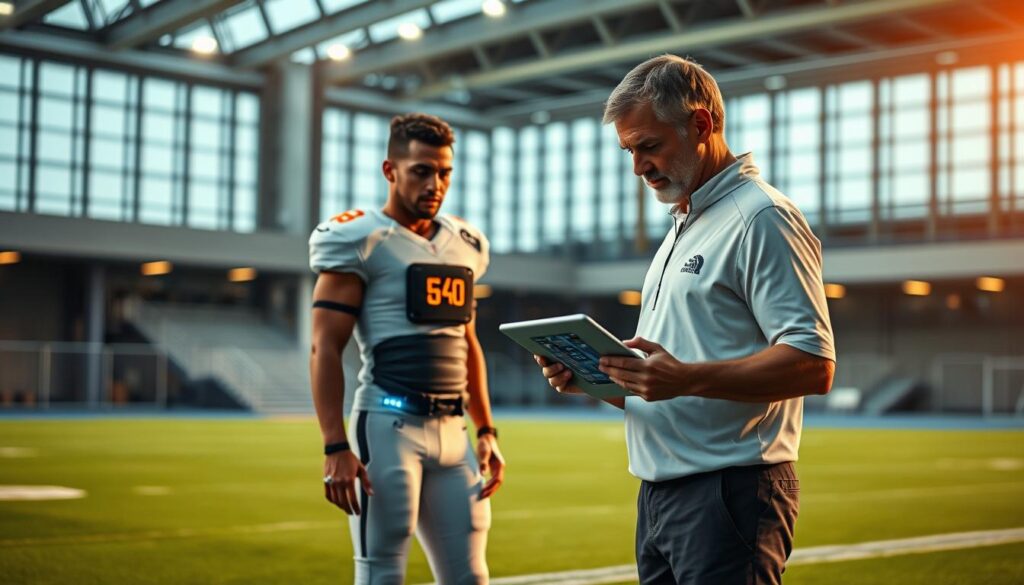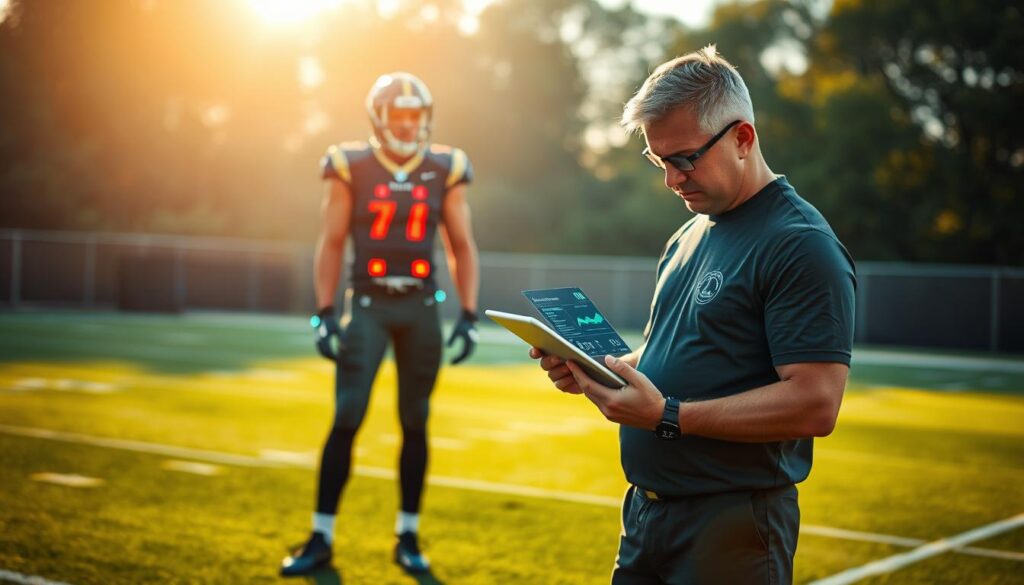Nearly 50% of professional athletes suffer from injuries that could be prevented with better monitoring and early detection. The NFL’s innovative “Digital Athlete” program, powered by data and AI, is a pioneering example of how technology can help prevent injuries. Traditional methods, such as stretching and warm-ups, are still essential, but they don’t address the data-driven needs of today’s athletes.
![]()
The integration of IoT technology and AI is revolutionizing injury prevention in sports through real-time data collection and analysis. Wearable technology provides unprecedented insights into athlete health and performance, enabling coaches and athletes to make proactive health decisions.
Key Takeaways
- The use of IoT and AI in sports medicine is transforming athlete safety and performance outcomes.
- Real-time data collection and analysis are crucial for preventing injuries.
- Wearable technology provides valuable insights into athlete health and performance.
- Proactive prevention is becoming increasingly important in modern sports.
- The NFL’s “Digital Athlete” program is a pioneering example of injury prediction technology.
The Rising Epidemic of Sports Injuries
The sports world is witnessing an alarming rise in injuries, threatening the careers of athletes across various disciplines. This surge in injuries not only affects athletes’ performance but also has significant financial implications for sports organizations.
The need for effective prevention and monitoring strategies has become more pressing than ever. By leveraging wearables and advanced data analytics, teams can now adopt a proactive approach to managing athlete health.
Current Statistics and Impact on Athletic Careers
Recent statistics reveal a disturbing trend in sports injuries, with many athletes facing career-threatening conditions. The impact on their careers is significant, often resulting in lost playing time, decreased performance, and in severe cases, premature retirement. Data analysis plays a crucial role in understanding these trends and identifying potential risk factors.
By examining patterns in injury data, sports medicine professionals can develop targeted interventions to mitigate risks and improve athlete health.
The Shift from Reactive to Proactive Injury Management
The traditional reactive approach to sports injuries is giving way to a more proactive strategy, driven by advancements in technology. Continuous monitoring through wearables enables the collection of real-time data on athlete biometrics and kinematics, allowing for early detection of potential issues.
- Continuous monitoring enables the early detection of potential issues, reducing the risk of severe injuries.
- Data-driven insights facilitate informed decision-making regarding athlete training and recovery protocols.
- The proactive approach not only prevents injuries but also optimizes athlete performance and extends their careers.
Understanding IoT Athlete Monitoring Systems
IoT athlete monitoring systems represent a significant advancement in sports medicine, offering real-time insights into athlete health and performance. These systems leverage wearable technology to track various physiological and biomechanical parameters, enabling coaches and trainers to make data-driven decisions.
Wearable Sensor Technology in Sports
Wearable sensor technology has become increasingly prevalent in sports, allowing for the collection of detailed physiological data during training and competition. This technology enables the monitoring of athletes’ vital signs and movement patterns in real-time.
Types of Biometric Data Collected
IoT wearables can collect a wide range of biometric data, including heart rate, body temperature, and muscle fatigue indicators. This information is crucial for understanding an athlete’s physical state and identifying potential injury risks.
Real-Time Monitoring vs. Traditional Assessment Methods
Traditional assessment methods, such as periodic physicals and fitness tests, have limitations in capturing an athlete’s condition during intense training or competition. In contrast, real-time monitoring through IoT devices provides immediate feedback, allowing for instant adjustments to training intensity or recovery protocols. This continuous data collection creates comprehensive athlete profiles, revealing patterns and trends that periodic assessments may miss, ultimately enhancing injury prevention and optimizing performance.
The Science Behind AI Injury Prediction

By leveraging machine learning algorithms, AI systems can now predict injuries with remarkable accuracy. This capability is revolutionizing the field of sports medicine, enabling teams to take proactive measures to prevent injuries to their athletes.
How Machine Learning Algorithms Detect Injury Risk Patterns
Machine learning algorithms are at the heart of AI injury prediction systems. These algorithms analyze vast amounts of data to identify patterns that may indicate a heightened risk of injury. By processing information on athletes‘ past injuries, training regimens, and biomechanical data, AI can forecast potential injuries before they occur.
Predictive Analytics and Biomechanical Assessment
Predictive analytics combines historical and real-time data to predict future outcomes. In the context of sports injuries, this involves assessing an athlete’s biomechanics, such as movement patterns and physical condition, to identify potential risks. This technology enables coaches and trainers to adjust training programs to mitigate these risks.
Case Study: The NFL’s “Digital Athlete” Program
The NFL’s “Digital Athlete” program is a groundbreaking initiative that utilizes AI and IoT technology to predict and prevent injuries. By integrating impact sensors into helmets and leveraging advanced AI analytics, the program creates digital models of players to assess injury risk. This program demonstrates the practical application of AI injury prevention in one of the world’s most physically demanding sports.
The use of AI in injury prevention is transforming how teams manage player safety and performance. As this technology continues to evolve, it is likely to have a significant impact on the future of sports medicine.
Critical Metrics for Injury Prevention
Effective injury prevention in sports requires a multifaceted approach that incorporates various critical metrics. By monitoring and analyzing these metrics, coaches and trainers can identify potential risks and take proactive measures to prevent injuries.
Heart Rate Variability (HRV) and Recovery Status
Heart Rate Variability (HRV) is a crucial indicator of an athlete’s recovery status. HRV measures the variation in time between heartbeats, providing insights into the autonomic nervous system’s balance. A lower HRV may indicate fatigue or stress, suggesting that an athlete needs rest. By monitoring HRV, coaches can adjust training programs to ensure adequate recovery and prevent overtraining.
Movement Pattern Analysis and Biomechanical Imbalances
Movement pattern analysis is vital for identifying biomechanical imbalances that could lead to injury. IoT wearables and AI-powered systems can analyze an athlete’s movement patterns, detecting anomalies that may indicate potential issues. For instance, abnormal running mechanics can lead to overuse injuries if not addressed. By correcting these imbalances through targeted training, athletes can reduce their risk of injury.
Training Load Management and Fatigue Indicators
Training load management is critical for preventing fatigue-related injuries. IoT devices can track various fatigue indicators, such as elevated resting heart rate and decreased power output. By analyzing these metrics, coaches can determine when athletes are approaching overtraining and adjust their training loads accordingly. Proper training load management ensures that athletes can perform at their best while minimizing the risk of injury.
| Metric | Description | Importance |
|---|---|---|
| HRV | Measures the variation in time between heartbeats | Indicates recovery status and fatigue levels |
| Movement Pattern Analysis | Analyzes an athlete’s movement patterns to detect biomechanical imbalances | Helps prevent injuries by identifying potential issues |
| Training Load Management | Monitors and adjusts training loads to prevent overtraining | Crucial for maintaining athlete performance and preventing fatigue-related injuries |

Mobile Recovery Trackers: Bridging the Gap Between Data and Action
The integration of mobile technology in sports has given rise to innovative recovery tracking solutions that are revolutionizing athlete care. Mobile recovery trackers are designed to provide athletes and coaches with real-time data and insights, enabling them to make informed decisions about recovery protocols.
Features of Effective Recovery Applications
Effective recovery applications offer a range of features, including personalized recovery plans, real-time monitoring, and data analytics. These features enable athletes to track their progress and make adjustments as needed. At Iottive, we specialize in Mobile App Development and Cloud & Mobile Integration, creating solutions that connect wearable devices with user-friendly mobile applications for effective health monitoring and recovery tracking.
Personalized Recovery Protocols Through Mobile Platforms
Mobile recovery trackers allow for the creation of personalized recovery protocols tailored to individual athletes’ needs. By analyzing data from wearable devices and other sources, these platforms provide coaches and medical staff with valuable insights to inform their decisions. The NBA, for example, uses wearable devices from Catapult Sports to track player load, movement, and fatigue levels, helping teams identify when players are at risk of injury.
Integration with Team Management Systems
Mobile recovery trackers can be integrated with broader team management systems, providing coaches and medical staff with comprehensive athlete monitoring capabilities. This integration enables coordinated approaches to athlete management, facilitating communication between athletes, coaches, medical staff, and strength and conditioning specialists. By leveraging these integrated systems, teams can make data-driven decisions at both individual and team levels, optimizing training plans and recovery strategies.
Implementing a Data-Driven Injury Prevention Program
The key to successful injury prevention lies in implementing a data-driven program that combines cutting-edge technology with expert knowledge. By leveraging IoT and AI technologies, sports teams can gain valuable insights into athlete health and performance.
Building the Technology Infrastructure
A robust technology infrastructure is essential for a data-driven injury prevention program. This includes wearable sensor technology and data analytics platforms that can collect and process large amounts of data. Companies like Iottive specialize in custom IoT products and end-to-end IoT/AIoT/smart solutions, helping organizations build the necessary infrastructure.

Establishing Baseline Measurements and Individual Profiles
To effectively prevent injuries, it’s crucial to establish baseline measurements and individual profiles for each athlete. This involves collecting data on various biometric markers, such as heart rate variability and training load. By analyzing this data, coaches and trainers can identify potential risk factors and develop targeted interventions.
Creating Intervention Protocols Based on Data Triggers
Effective intervention protocols are critical to preventing injuries. These protocols should be triggered by specific data patterns or threshold breaches in athlete monitoring systems. For example, if an athlete’s heart rate variability falls below a certain threshold, the protocol might include modifying their training regimen or initiating recovery protocols. By having clear communication channels and responsibility assignments, teams can respond promptly and effectively to potential injury risks.
- Develop intervention protocols based on data triggers and research evidence.
- Establish clear communication channels and responsibility assignments.
- Continuously monitor and adjust protocols to optimize injury prevention.
Real-World Success Stories: Teams and Athletes Transformed by Technology
Technology is transforming the sports landscape, with numerous teams and athletes benefiting from advanced injury prevention systems. By leveraging IoT athlete monitoring and AI-driven analytics, sports organizations can now proactively manage athlete health.
Professional Sports Organizations Leading the Way
Professional sports teams have been at the forefront of adopting innovative technologies to enhance athlete safety. For instance, the NFL’s “Digital Athlete” program uses AI and machine learning to predict and prevent injuries. This has led to a significant reduction in injury rates among participating athletes.
| Team | Technology Used | Outcome |
|---|---|---|
| NFL Teams | AI-driven injury prediction | Reduced injury rates |
| NBA Teams | Wearable sensor technology | Improved player availability |
Collegiate and Amateur Athletics Applications
The benefits of injury prevention technology are not limited to professional sports. Collegiate and amateur athletic programs are also adopting these innovations to protect their athletes. AI-based solutions, such as telemedicine and wearable technologies, are making comprehensive injury evaluation and rehabilitation programs more accessible.

By implementing data-driven injury prevention programs, coaches can make informed decisions to safeguard athlete health and optimize performance. As the technology continues to evolve, we can expect to see even more effective applications in the future.
Conclusion: The Future of Sports Medicine in the Age of Data
The integration of IoT and AI in sports medicine is revolutionizing athlete care by providing data-driven approaches to injury prevention. As technology evolves, we can expect more advanced sensors and AI-driven models that offer real-time injury predictions and personalized training plans. Future wearables will track key data like muscle fatigue and joint stress, enabling coaches to make proactive adjustments to prevent injury. With these innovations, IoT will play a crucial role in keeping athletes safer, improving performance, and extending careers. Iottive is positioned to help organizations implement cutting-edge IoT and AI solutions for athlete monitoring and injury prevention, enhancing overall health and sports performance.
The future of sports medicine looks promising with the continued adoption of these technologies across all levels of sport, creating a safer and more sustainable sporting environment.
FAQ
How does heart rate variability (HRV) impact injury prevention in sports?
Heart rate variability is a critical metric for assessing an athlete’s recovery status and readiness to train. By analyzing HRV, coaches and trainers can adjust training loads to prevent overtraining and reduce the risk of injuries.
What is the role of wearable sensor technology in athlete monitoring?
Wearable sensors track various biometric data, including heart rate, movement patterns, and muscle fatigue. This information enables coaches to identify potential injury risks and develop targeted interventions to mitigate them.
How do machine learning algorithms detect injury risk patterns?
By analyzing large datasets, machine learning algorithms can identify complex patterns and anomalies in biometric data that may indicate an increased risk of injury. This enables coaches and trainers to take proactive measures to prevent injuries.
What are the benefits of using mobile recovery trackers for athletes?
Mobile recovery trackers provide athletes with personalized recovery protocols and real-time feedback on their progress. This helps athletes optimize their recovery, reduce the risk of injuries, and improve overall performance.
How can training load management help prevent injuries?
By analyzing training load data, coaches can identify athletes who are at risk of overtraining and adjust their training programs accordingly. This helps prevent injuries and ensures that athletes are adequately prepared for competition.
What is the significance of biomechanical assessment in injury prevention?
Biomechanical assessment helps identify movement patterns and imbalances that may contribute to injury risk. By addressing these issues through targeted interventions, coaches and trainers can reduce the risk of injuries and improve overall athlete health.